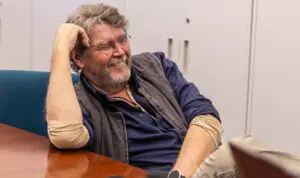John Cronin (no relation) was recently named head of Pace University’s newly created Gale Epstein Center for Technology, Policy and the Environment, funded by Gale Epstein, the co-founder, creative director and president of Hanky Panky, an intimate apparel company. Both Cronin and Epstein live in Philipstown.

What is the purpose of the center?
I’ve been doing environmental work for 50 years, and one of the big lessons I’ve learned is that no matter how hard we fight to prevent and treat pollution, some of it will reach people. For instance, people don’t know what’s in their drinking water before they drink it. They don’t have a guarantee of clean water.
The City of Beacon issues an annual water quality report in June, but the data is from the previous calendar year, so it’s 18 months old — useless. Let’s say there’s contamination. Beacon has 24 hours to inform you that the water is dangerous, using press releases, radio announcements, posters and door-to-door messengers. There is no requirement that you be immediately notified by text or email — nothing. No municipality in the country has that requirement.
If you had that immediate information, you’d stop drinking your water. But tens of millions of people get sick because they don’t have that information in an emergency. If water suppliers have other problems that aren’t emergencies, they have 30 days to tell you. This is 2025! We get storm alerts on our phones and Amber Alerts [about missing children]. I get pollen alerts, for God’s sake! I can tell you the weather on Mars but nobody knows what’s in the water before they drink it.
This “right-to-know” concept is at the heart of the Epstein Center. People have a right to know the quality of their environment using the immediate means that we are all accustomed to. Instead of using laboratory analysis to detect what’s in water, there will be sensors everywhere that identify pollutants and send out alerts.
How will the students be involved?
I’m located in the Seidenberg School of Computer Science and Information Systems, and these students are unbelievably talented. They’ve known what they want to do since they were little. It’s hard to be a young practitioner if you’re interested in law or business or journalism, but when you’re 10 years old, you can be your family’s IT officer. These students are so excited to use their skills to protect public health and protect people from environmental threats. We have sensors in our campus pond that deliver real-time water quality information, and one student developed a mobile app so my phone tells me when the oxygen level drops. Another student created an SMS bot: You text the phone number and get a response that tells you the water quality within the last 15 minutes.
My students are also interested in policy. Last year, seven of them won UN Millennium fellowships. Based on their research and the work we’ve done, we’re going to present a petition at the United Nations to make right-to-know drinking water quality a fundamental human right.
How has climate change threatened drinking water?
Increased rainfall, increased storms, increased erosion and sea-level rise mobilize contaminants. When we had Hurricane Sandy [in 2012] and the Beacon Metro-North parking lot was inundated up to the steering wheels, people tried to research all this unexpected water quickly. What was it mobilizing back into the river? All these events, particularly superstorms, mobilize pollutants and pathogens because of the proximity to parking lots, feedlots, agriculture and so on.
How would you pitch this to the incoming Trump administration?
First, if you provide this information in an immediate form, you’re taking a burden off of municipalities and local water supplies. Second, it’s a tech industry that could be worth a billion dollars. We can launch it here, but it could have a worldwide application. Third, it’s a public health imperative. It doesn’t gore anybody’s oxen. We’re not talking about a crackdown on a particular pollutant.
Do you think people would use the system?
Remember when The Weather Channel came out? Everybody laughed! Who’s going to watch the weather? Now people are even watching other people’s weather. They like direct, real information. You can do that with water.

